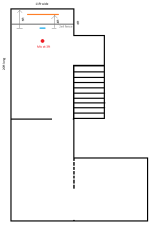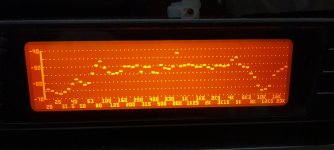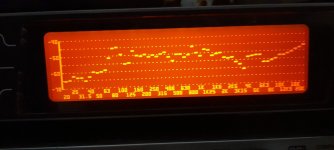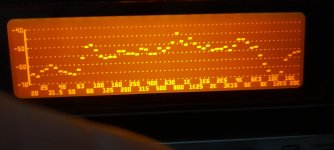I agree that directivity of the DML is probably wider than the 3" planar you tested or your tower speakers. I have the same conclusion comparing a DML to a small 8cm full range. Some papers even mentioned that the increase of the energy with the frequency is so the directivity index increases with the frequency where the work from F Toole concludes it should decreases. So this might not be good for living (= not dead or absorbant)) "small" room.@homeswinghome here you go: https://ninjafiles.io/B9P/planar-vs-rubberized-xps.mdat
I'm speculating that the directivity is just really wide for all frequencies so in a medium-small living room without any treatment the center image loses focus. If my room were bigger or if there were a lot of absorbers on the walls then it would probably sound a lot better to me.
I think DML is best suited for a large open area (PA), but probably not the best for stereo in a living room. It might be a good center channel though.
I've been doing a lot of research into open baffles, dipoles, cardioids, and directivity / imaging in general and it seems to me that the best speaker should be made to target the listening window while minimizing the influence of the room by sending less energy outside of the listening window. I don't think there's a good way to do this with DML.
It's just a theoretical personal preference at this point, but I don't think I want to add artificial spaciousness with wide directivity speakers in a reflective room. Adding absorbers in the family area is not an option for me, so I'm looking at different kinds of speakers to better control the directivity.
In your measurements, we can see the a strong reflection near 2ms for the panels. The planar doesn't show it. As the positions are similar it is the planar doesn't radiate to the according surface. I am not sure about all the dimensions in your room to conclude it is the floor.
Have you investigated more to understand from which direction or surface it comes?
In an other hand, with a lack of (side?) reflection, it might be an image not at speakers plan but more "in your head" as with headphones. I have a pair of line arrays as other loudspeakers (16 full range each) which have this problem.
I am really interested in the design possibilities as I have a new room here, not very wide (about 3.5m) for which I would like to build loudspeakers. Due to this directivity question, I wonder if DMLs are the way to go, or what are the constraints for DML in such a case.
@SapphireSloth
In my previous post, I forget to mention alternatives to keep DML in such rooms :
For the level of reflections, there is a graph from M Toole's work (see in his book or on different sites. Here copied from Acoustic frontiers early reflections). I am not sure about its use but my understanding is the system (loudspeakers + room) should be between A and B in the spaciousness area. Above B, the image is not precise. Below A, there is a lack of space...
To be followed... I will such for measurements of my line arrays... which are far deeper in my computer.



In my previous post, I forget to mention alternatives to keep DML in such rooms :
- change the panel material. Below are the IR of an EPS panel (20mm, 35x80cm, PVA coated) in blue and a PS panel (1.2mm, 30x40cm). The position in room was about the same for both. There are less early reflections with the PS. PS stands here for polystyrene. It is the clear glass in front of a frame to protect the picture. It is easily available here in DIY store in different thickness (1.2, 2, 5mm), there is also an opaque white version. It is quite heavy but a bit lighter than acrylic. The drawback is the lack of efficiency compare to EPS. The coincidence frequency is expected to be rejected out of the audio range in 1.2mm thickness. To increase the thickness will lower the coincidence frequency; not tested.
- use a crossover and a tweeter. Last year, I built a panel with a sheet of corrugated polypropylene. It had not enough HF so I added a tweeter (a Fostex FT17H I have). The IR are in the graph after. Orange if the full loudspeaker (bass + DML + tweeter), green is the tweeter alone not filtered but probably not at the same position in the room.. The problem with a tweeter is it adds a crossover but the main question is how the field (SPL) of the tweeter decreases (suppose -6dB/doubling distance) with the distance compare to the DML (a previous experience with my large plywood panel shown more -3dB/doubling distance).
For the level of reflections, there is a graph from M Toole's work (see in his book or on different sites. Here copied from Acoustic frontiers early reflections). I am not sure about its use but my understanding is the system (loudspeakers + room) should be between A and B in the spaciousness area. Above B, the image is not precise. Below A, there is a lack of space...
To be followed... I will such for measurements of my line arrays... which are far deeper in my computer.
Maybe as mentioned above we should investigate more thoroughly the effect/s of curving panels.. in this case, concavity.Sorry to be late for this reply. Directivity of the DML and how it fits with the room setup is among my current question too
Eucy
Some more measurements of the veneer panel.
Pic 1
Is from the front all pics at about 8inches.
Pic 2
Is from the back of the panel.
The peaks are evident in the 800hz region causing a hump in the response.
Pic 3
Is from the front.
Is with eq to reduce the hump, but the single 800hz peak refuses to budge.
Pic 4
Is from the rear with the same eq .
This is a very good response up to about 6k ,before the exciter starts to block the hf.
I would be tempted to add some sort of tweeter and use this side facing forwards.
I have just added some more 50x50 mix of pva to the dome and it seems to be improving the response in the 3k to 8k area.
The paper used for the dome is very light and thin.
I will wait until the pva dries before adding more pva.
I have to apply the pva with a very thin art paint brush , even this thin brush caused the dome to collapse, but luckily I managed to blow through the hole in the rear of the exciter and re-inflate the dome.
Hopefully the response will improve after a few days drying.
Steve.
Pic 1
Is from the front all pics at about 8inches.
Pic 2
Is from the back of the panel.
The peaks are evident in the 800hz region causing a hump in the response.
Pic 3
Is from the front.
Is with eq to reduce the hump, but the single 800hz peak refuses to budge.
Pic 4
Is from the rear with the same eq .
This is a very good response up to about 6k ,before the exciter starts to block the hf.
I would be tempted to add some sort of tweeter and use this side facing forwards.
I have just added some more 50x50 mix of pva to the dome and it seems to be improving the response in the 3k to 8k area.
The paper used for the dome is very light and thin.
I will wait until the pva dries before adding more pva.
I have to apply the pva with a very thin art paint brush , even this thin brush caused the dome to collapse, but luckily I managed to blow through the hole in the rear of the exciter and re-inflate the dome.
Hopefully the response will improve after a few days drying.
Steve.
Attachments
Hello EucyMaybe as mentioned above we should investigate more thoroughly the effect/s of curving panels.. in this case, concavity.
Eucy
The coincidence frequency seems to play the first role, at least to avoid strong lobes out of the axis. It is possible following the theory to increase the coincidence frequency by increasing the areal density (heavier material so lower efficiency) and by decreasing the bending stiffness.
Curving the panel will focus the different areas to the axis. It might be a solution to avoid the loss of HF on axis. I imagine it will also increase the stiffness in the plan perpendicular to the curve so maybe some thickness reduction needed...
Christian
@homeswinghome My room is 11ft wide with TV 1ft from front wall, panel 4ft from TV. The depth of the room is about 20ft but has a 5ft wide walkway on one side connecting it to a "second living room". There's also a staircase going up. Here's a diagram:

This is how I've performed all of my indoor tests.
In the mdat I shared last we can see how much less controlled the DML is off-axis compared to the planar. At some frequencies the DML is louder at 45 degrees than it is on-axis. In these test I did not include a 60+ degree measurement but I have tested 60 before and it's the same story for DML. The planar is much more constant with a more equal reduction on dB all across the FR as the angle moves off axis (aside from the 6k-9k issue). This is pretty critical I think: "constant directivity".

I've considered experimenting again with a much more narrow panel, thinking that it might result in a more even horizontal off-axis response, but I already know it will have lots of other problems so I don't think it is worth trying.

This is how I've performed all of my indoor tests.
In the mdat I shared last we can see how much less controlled the DML is off-axis compared to the planar. At some frequencies the DML is louder at 45 degrees than it is on-axis. In these test I did not include a 60+ degree measurement but I have tested 60 before and it's the same story for DML. The planar is much more constant with a more equal reduction on dB all across the FR as the angle moves off axis (aside from the 6k-9k issue). This is pretty critical I think: "constant directivity".
I've considered experimenting again with a much more narrow panel, thinking that it might result in a more even horizontal off-axis response, but I already know it will have lots of other problems so I don't think it is worth trying.
The JMC soundboard looks plenty curved & apparently goes nearly full-spectrum 35-20KHz, using 8 "vibrators" for their almost 1m square panel. (Can't recall if anyone on this thread has heard these or not). Panel is curved outward/convexly towards the listener.Maybe as mentioned above we should investigate more thoroughly the effect/s of curving panels.. in this case, concavity.
Eucy
Conversely, the Teragaki Lab panels are curved inwards/concave.
Both examples of not-confirmed-but-probably-DML.
Curved panels would seem to make sense if wavefronts propagate spherically. Perhaps the curved panels function like a horn or waveguide for spherical wave propagation? Pure speculation! And if so, one of these examples would be 'wrong'. But which?
There is a strong resonance in the area of 13kHz visible in the 0d spectrogram. In what I experienced with EPS, the central area in the voice coil diameter acts like a second source (drum effect). It might be what you detect while rotating the panel.In the mdat I shared last we can see how much less controlled the DML is off-axis compared to the planar. At some frequencies the DML is louder at 45 degrees than it is on-axis. In these test I did not include a 60+ degree measurement but I have tested 60 before and it's the same story for DML. The planar is much more constant with a more equal reduction on dB all across the FR as the angle moves off axis (aside from the 6k-9k issue). This is pretty critical I think: "constant directivity".
I wonder if it is what reduces the quality of the image due to its high frequency.
Spedge wrote at different times about this and about countermeasure. (@spedge)
Maybe with his advice you could see what is the image after curring (lowering) this peak.
I still wonder of what happens in the 5kHz area which seems present at the same level first wave front, in the 2ms and 8ms reflections. The planar doesn't have this 2ms reflection and the level at this frequency at 8ms is much lower than the main front wave.
I what I would like to experiment with PS (not EPS...) is the early reflection content in the 5k range (here I have already some evidence showing a lower content than with the EPS I tested and the panel HF extention without the central area (in the current panel I tested, the central area is neutralized with a piece of aluminum glued. It avoid the central resonance but there is what was called here the voice coil noise - the noise on the back side from air escaping from the central area) .
Christian
Christian... Have you tried a flap of felt to cure this?but there is what was called here the voice coil noise - the noise on the back side from air escaping from the central area)
could you please provide an illustration of this please?Have you tried a flap of felt to cure this?
Homeswing.
I am glad that people are discussing the central drive problems , I have been going on about this problem for many years now, with very little interest show by most.
The method used by joppe peelen to drive this panel could solve this problem ?.
Or even using a piezo driver operating in bending wave only.
This would remove the main problem of using a circular coil with cavity, and the associated problem of the inner coil surface area, which are the main source of the nasty noises coming from the dml panels
Steve.
I am glad that people are discussing the central drive problems , I have been going on about this problem for many years now, with very little interest show by most.
The method used by joppe peelen to drive this panel could solve this problem ?.
Or even using a piezo driver operating in bending wave only.
This would remove the main problem of using a circular coil with cavity, and the associated problem of the inner coil surface area, which are the main source of the nasty noises coming from the dml panels
Steve.
@homeswinghome yes I've done a bunch of experiments with baffles/wings for the purpose of increasing LF response, which certainly works, but my latest round of H and U-style wings did not seem to improve the center image clarity much. Theoretically, in my mind, I think the wings would have to be quite deep to focus the 'beam' of sound enough and I don't have the space / WAF for this. Also, I imagine that it would cause some problems if it is not curved like a horn, which then introduces other problems and is even bigger.
Regarding reflections, the panel is much larger than the planar and the center of driver is about 1ft higher than center of planar, so I think the 2ms is floor bounce and 6-8ms is ceiling plus TV which are around the same distance away.
Idk if getting into the particulars really matters here because there is such a big difference in IR that there is clearly a big fundamental difference between the two, and for the use of stereo L/R in my medium sized living room I don't think it is sensible to try to make this work:

There are other issues too, like unstable FR with peaky modes, and begin too bulky and fragile. For now, I'm at the point where I want the best system in my living room and DML has too many strikes against it to continue trying to improve it. I feel silly but it's taken me ~10mo to rediscover that PA is a great use for DML technology, but home theater isn't a great application to use this for.
Since I have drivers I might make some speakers in the future for the garage, where the wide field and loudness over distance attributes are more useful. I might also try it as a center speaker because the wide radiation pattern may be more useful, and maybe as some cheap TV speaker replacements in bedrooms or w/e.
Regarding reflections, the panel is much larger than the planar and the center of driver is about 1ft higher than center of planar, so I think the 2ms is floor bounce and 6-8ms is ceiling plus TV which are around the same distance away.
Idk if getting into the particulars really matters here because there is such a big difference in IR that there is clearly a big fundamental difference between the two, and for the use of stereo L/R in my medium sized living room I don't think it is sensible to try to make this work:
There are other issues too, like unstable FR with peaky modes, and begin too bulky and fragile. For now, I'm at the point where I want the best system in my living room and DML has too many strikes against it to continue trying to improve it. I feel silly but it's taken me ~10mo to rediscover that PA is a great use for DML technology, but home theater isn't a great application to use this for.
Since I have drivers I might make some speakers in the future for the garage, where the wide field and loudness over distance attributes are more useful. I might also try it as a center speaker because the wide radiation pattern may be more useful, and maybe as some cheap TV speaker replacements in bedrooms or w/e.
Hello Eucy. No... Thank you to remind this solution!Christian... Have you tried a flap of felt to cure this?
Clearly if the DML was a nice speaker with a smooth FR we'd see them in almost all the loudspeaker brands... but the story is not so simple. It remains the DMLs have an interesting sound. I don't think there is a global approach possible. Each problem has to be identified and hopefully a solution exists... or not!Idk if getting into the particulars really matters here because there is such a big difference in IR that there is clearly a big fundamental difference between the two, and for the use of stereo L/R in my medium sized living room I don't think it is sensible to try to make this work:
There are other issues too, like unstable FR with peaky modes, and begin too bulky and fragile. For now, I'm at the point where I want the best system in my living room and DML has too many strikes against it to continue trying to improve it. I feel silly but it's taken me ~10mo to rediscover that PA is a great use for DML technology, but home theater isn't a great application to use this for.
Since I have drivers I might make some speakers in the future for the garage, where the wide field and loudness over distance attributes are more useful. I might also try it as a center speaker because the wide radiation pattern may be more useful, and maybe as some cheap TV speaker replacements in bedrooms or w/e.
To try to find a way in that needs time... and nothing tell it will work for sure in any situation or location. I understand your position. I am interested to know which other solution you will go for. As it might be out of the scope of this thread, please use a personal message or a link to an other thread.
Christian
Interesting Steve, but it's not obvious to me how this panel is actually driven. Does he explain it anywhere? Or do you think you understand what he's actually doing?The method used by joppe peelen to drive this panel could solve this problem ?.
Eric
Dayton EMM-6 Cal charts
Off topic I know but...
I am considering getting one of these and I thought it would be interesting to chart some of the spread of cal files - so here are some representative ones based on random serial numbers - the text files can be downloaded from the Dayton site - more can be added if anyone is interested.
Eucy
Off topic I know but...
I am considering getting one of these and I thought it would be interesting to chart some of the spread of cal files - so here are some representative ones based on random serial numbers - the text files can be downloaded from the Dayton site - more can be added if anyone is interested.
Eucy
Attachments
Check out this guy's horn for a line array of planars: planar array hornTheoretically, in my mind, I think the wings would have to be quite deep to focus the 'beam' of sound enough
I'm thinking that's what DML would need to control the directivity for use in a living room 🤣
Intriguing... DML's are purported to have less room interaction than box speakers - your room does look difficult in audio terms I guess. I put the main dims of 20ft and 11 ft in the Linkwitz spreadsheet (modes1.xls) (assumed an 8ft ceiling) and it didn't like it. If the length was reduced to 16ft it was OK, but you have other openings into large spaces which confuses the situation.@homeswinghome My room is 11ft wide with TV 1ft from front wall, panel 4ft from TV. The depth of the room is about 20ft but has a 5ft wide walkway on one side connecting it to a "second living room". There's also a staircase going up. Here's a diagram:
View attachment 1334106
This is how I've performed all of my indoor tests.
In the mdat I shared last we can see how much less controlled the DML is off-axis compared to the planar. At some frequencies the DML is louder at 45 degrees than it is on-axis. In these test I did not include a 60+ degree measurement but I have tested 60 before and it's the same story for DML. The planar is much more constant with a more equal reduction on dB all across the FR as the angle moves off axis (aside from the 6k-9k issue). This is pretty critical I think: "constant directivity".
View attachment 1334115
I've considered experimenting again with a much more narrow panel, thinking that it might result in a more even horizontal off-axis response, but I already know it will have lots of other problems so I don't think it is worth trying.
Eucy
From memory I think he did a Heath Robinson(ish) form of a Magnepan type linear motorInteresting Steve, but it's not obvious to me how this panel is actually driven. Does he explain it anywhere? Or do you think you understand what he's actually doing?
Eric
- Home
- Loudspeakers
- Full Range
- A Study of DMLs as a Full Range Speaker



